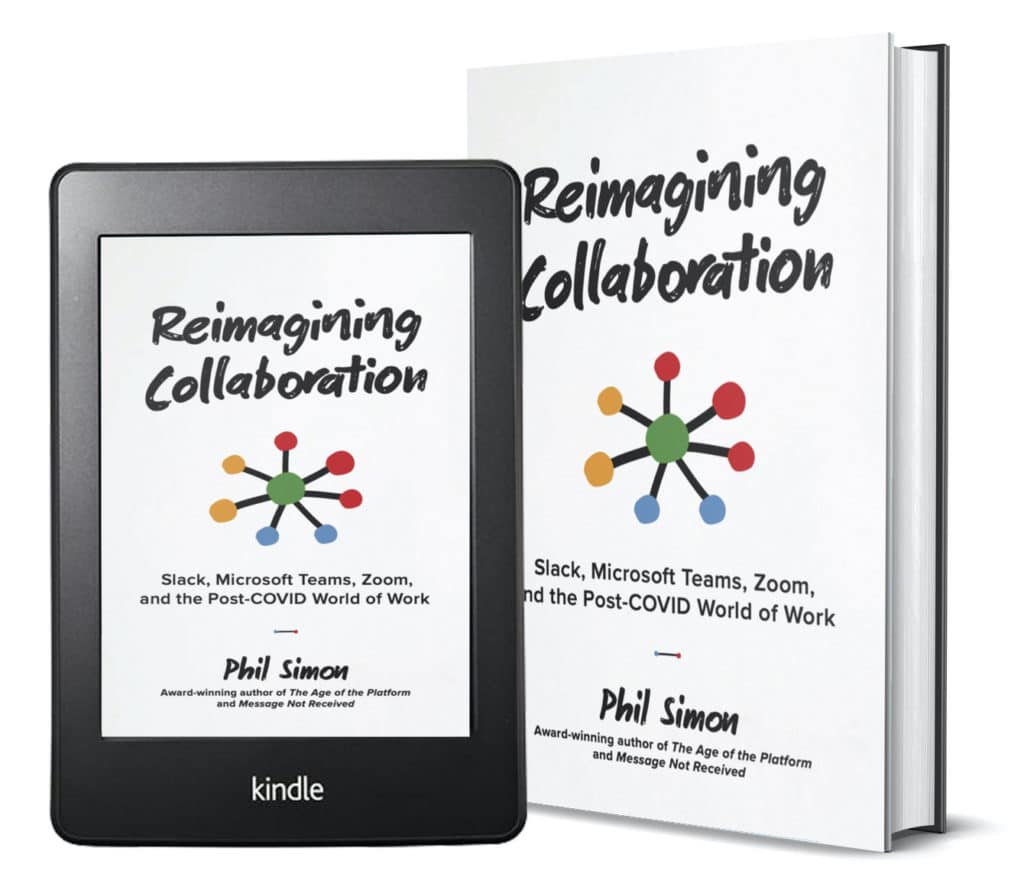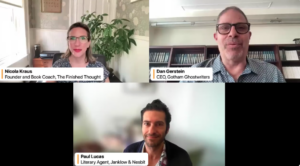I’ve had the pleasure of talking to dozens of authors over the years. During those often fascinating conversations, I have learned that a book’s backstory is often as interesting as the idea behind the book itself—if not more so. That may well be the case with my new book Reimagining Collaboration: Slack, Microsoft Teams, Zoom, and the Post-COVID World of Work.
Let me explain.

By way of background, my previous two books were Slack For Dummies and Zoom For Dummies, respectively. As I was writing the latter, it dawned upon me how much the two internal collaboration hubs had in common. In point of fact, they were far more similar than dissimilar. To be fair, few readers of each book noticed that commonality. After all, the For Dummies guides are more tactical than conceptual in nature.
In August of 2020, Zoom For Dummies hit the shelves after a furious writing sprint. (I had penned 110,000 words in seven weeks.) By then, a few things had become apparent. First, the long-predicted second wave of the pandemic was coming. Second, we weren’t going back to our offices anytime soon. Finally, even when a vaccine arrived, in a way it wouldn’t matter because prominent companies were extending remote work indefinitely.
The First Incarnation: Yet Another Book About the Future of Work
Against this backdrop, I started developing a proposal for a book about the future of work. I saw collaboration hubs from Slack, Zoom, Microsoft, and other software vendors as a key part of a larger—and long overdue—shift away from internal corporate email. Collaboration and the nature of work were changing before our eyes.
My agent pitched the proposal to acquisitions editors at prominent publishers. I felt good about the core thesis of the book, but their interest was generally underwhelming. (One AE floated the idea of morphing my book into a far more technical text that I was quite frankly unqualified to write.)
As for the tepid response, my recent pre-Dummies book sales didn’t exactly scream rock star or sure thing. (That’s a conversation for beers sometime.) Beyond that, my agent informed me that a number of publishers had recently inked book deals on the future of work. They understandably didn’t want to cannibalize sales of their forthcoming titles. (My friend Josh Bernoff correctly points out that the recent publishing mega-merger means that authors can expect more of these types of decisions.)
The Second Incarnation: A Guide in a Prominent Series
Although a tad discouraged, I had already been conceiving of different scenarios should my agent fail to attract sufficient interest. In early September, he told me that he wouldn’t be able to find a home for my book. I thanked him for his efforts and told him that I was going to pursue other avenues. I wasn’t willing to abandon this idea. (Yeah, I’m stubborn.)
By then, I had already reached out to the creator of a prominent series of short business books. (I’ll call him Alex here, but that’s not his name.) Our introductory conversation had gone well. I sent him copies of my last two books and he returned the favor.
During our second chat in mid-September, I mentioned that the idea of writing a guide for his series intrigued me—and the feeling was mutual. We quickly landed on a topical guide on virtual or remote collaboration and signed a contract.
I read a few of the series’ short guides to get a sense of the expected tone and content. I then wrote an outline and shared it with Alex. After incorporating his feedback, I cranked out the 30,000-word manuscript.
Throughout the writing and editing process, I couldn’t escape a niggling feeling: Did my proposed guide really mesh with the others in the series? Just in case, I started to conceive of alternative book ideas if the answer to my question was no. I spoke to three of my author friends who wouldn’t hold back their honest opinions. By late October, I estimated that there was a 20 percent chance that I’d have to cut bait.
That ain’t nothin’.
I started developing the equivalent of an insurance policy. To this end, I made a few calls to:
- My cover designer for the majority of my previous books.
- A local book-design shop about rates and logistics.
- The president of Motion Publishing—the company that I founded in 2010 and sold in 2017.
I wanted to get on their radar should things change. I also started mocking up new book covers and titles in Canva. My consigliere Alan Simon warned me that my actions might be premature. Maybe he was right. Still, as OG Franz Kafka famously said, “Better to have and not need than to need and not have.”
A Different Approach Yields the Same Result
It turns out that my concern about series fit was well founded.
A few days after submitting the final manuscript, Alex sent me his notes and suggestions. They weren’t light. At a high level, in order for my book to work in his series, I needed to remove significant portions of my manuscript and rework others. The words major surgery came to mind.
Now, I consider myself amenable to constructive feedback. I reviewed his proposed changes, but I just didn’t agree with the vast majority of them. Alex wanted me to remove or at least minimize the big idea at the center of my book. In a nutshell, Slack, Microsoft Teams, Zoom, and other collaboration hubs weren’t just Email 2.0. Coupled with other applications that I call spokes, these hubs could transform organizations. Specifically, they could increase organization transparency, reduce manual work, streamline business processes, and much more.
Unfortunately, big-idea books just didn’t work in the context of a series of short, tactical business guides. I realized that I was trying to put a square peg in a round role.
Beyond that, I’ve developed a sense of confidence in my writing over the years. No, I’m not infallible, but I know what I’m doing at this point in my career. As my friend and fellow author Scott Berkun reminded me during one of our recent chats, after ten previous books, I’ve learned a thing or six.
Because of some rudimentary contingency planning, my book quickly began to take its natural form.
A few days later, Alex and I met over Zoom to discuss our next steps. Within minutes, we realized that the book that I wanted to write just didn’t make sense for his series. Our conversation was the very definition of an amicable breakup—one of the most professional disagreements that I’ve ever had. We both apologized for any misunderstandings, invoked the termination clause in our contract, and parted ways. Neither one of us holds any ill will towards the other.
The Third—and Final—Incarnation: Reimagining Collaboration
After two instructive but less-than-fruitful directions, my thinking on the book had crystallized. I now knew exactly what it would—nay, needed to—be. I was downright giddy. Freed from the justifiable shackles of the series or a fickle publisher, I was chomping at the bit. The contingency planning allowed my book to quickly take its natural and final form.
More specifically, the time that I spent noodling with alternative cover designs, titles, subtitles, and directions paid in spades. Within a week of parting ways with Alex, I had completely reimagined the book. I wrote another 12,000 words, landed on a cover, title, and subtitle, and conceived of a complementary podcast to help promote the book. Bottom line: It arrives via Motion Publishing this month.
Simon Says: Listen to Eisenhower.
To call the route that my new baby took circuitous is the acme of understatement. Its first two incarnations ultimately didn’t land with their intended audiences. Thanks to a little contingency planning, however, I minimized disruption and any subsequent frustration. Most important, I was ultimately able to write the book that was inside me all along.
Dwight D. Eisenhower once said, “Peace-time plans are of no particular value, but peace-time planning is indispensable.” Smart dude. Whether you’re a first-time or an experienced author, you should heed Eisenhower’s words.
Author
-
Phil Simon is a recognized technology and collaboration authority. He is the award-winning author of eleven books, most recently Reimagining Collaboration: Slack, Microsoft Teams, Zoom, and the Post-COVID World of Work. He consults organizations on analytics, communications, strategy, data, and technology. His contributions have been featured on The Harvard Business Review, CNN, The New York Times, and many other prominent media outlets. He also hosts the podcast Conversations About Collaboration.
View all posts



